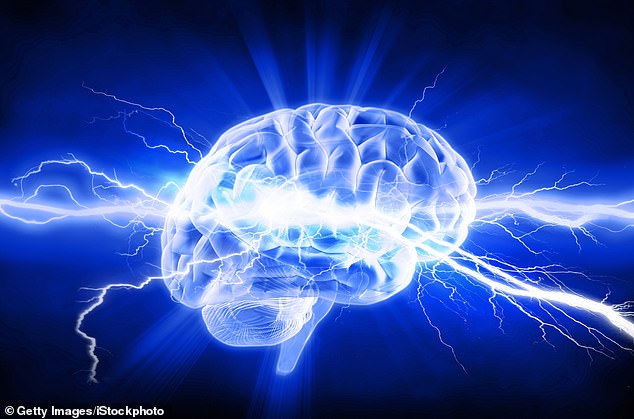Why so many middle-aged people are having their first seizure, just like the female driver who killed two children at Wimbledon school – and the signs doctors give that mean you could be at risk
Laura Bennett was working from home one morning in November 2022 when she started to feel a little under the weather: tired, having trouble concentrating, and feeling a bit disconnected from the world around her.
“I told my husband Matt I was going upstairs to have a lie down,” says Laura, 47, a marketing manager and mother of one from West Sussex.
But when she went to the toilet on the way, Laura suddenly had a seizure all over her body. It was so severe that she fell to the ground.
In 2022, Laura Bennett was told she had adult-onset epilepsy and would likely need to take daily anti-epileptic drugs for the rest of her life
“I don’t remember anything, but apparently Matt ran up the stairs and was terrified when he saw me lying on the floor,” Laura says.
‘I had a very severe attack. I later found out that a severe attack lasts five minutes or so — mine lasted almost eight.
Matt called an ambulance and managed to protect me from injury by pushing me against the tub and holding my head in case I bumped into something.
“When I came to, I couldn’t speak for the next seven or eight hours because of the effects of the attack on my brain. Nothing like this had ever happened before.”
Laura was rushed to hospital and underwent an electroencephalogram (a scan of the electrical activity of the brain). There she was told that she had adult-onset epilepsy and that she would likely need to take daily anti-epileptic drugs for the rest of her life.
A terrifying incident, no doubt about it. Yet Laura knows she was lucky to have been in the relative safety of her own home, with her husband present, when it happened.
But just how dangerous an attack like this can be out of nowhere was illustrated all too clearly by the tragic deaths of two eight-year-old girls last year, when they were hit by a car, causing the driver behind the wheel to suffer a stroke.
Nuria Sajjad and classmate Selena Lau were killed when a car driven by 47-year-old mother of three Claire Fremantle drove through a fence and collided with them as they sat on the grass during a closing tea party in Wimbledon, south-west London.
Ms Fremantle was initially charged with dangerous driving but was cleared last week after medical tests confirmed she had epilepsy. It was her first seizure and she had no idea she was a risk.
She is now taking medication to reduce the seizures and has surrendered her driving licence to the Driver and Vehicle Licensing Agency (DVLA).
Strict rules mean drivers could be fined up to £1,000 if they fail to alert the DVLA when they have a seizure or blackout, and not just while behind the wheel.
About one in every 100 people — or 630,000 in the UK — has epilepsy. Although it’s usually thought of as something that affects teenagers and young adults, around 8,000 middle-aged and older adults are also diagnosed each year.
It is characterized by sudden bursts of uncontrolled electrical activity in the brain, which prevents nerve cells from communicating properly with each other. This causes seizures in which everything from muscle control to senses such as taste and smell is completely disrupted for a few minutes.
This leads to seizures, which for some people simply means their food tastes strange, while others react so severely that they pass out.

Nuria Sajjad and classmate Selena Lau were killed when a car driven by 47-year-old mother of three Claire Fremantle drove through a fence and collided with them as they sat on the grass at an end-of-term tea party in Wimbledon
The main treatment is anti-epileptic drugs to reduce the risk of seizures by changing the electrical activity in brain cells so that they are less ‘excitable’ and less likely to misfire. More severe cases may require surgery to remove a small part of the brain that is causing the seizures.
Other approaches include implanting a small electrical device in the body and connecting it to the brain to interrupt the chaotic signals between nerve cells, or following a ketogenic diet – low in carbohydrates and high in protein and fat – which is thought to reduce the “excitability” of nerve cells and may halve the number of episodes.
In children, epilepsy is usually caused by brain abnormalities that are present from birth.
In many adult cases, like Laura’s, it’s completely arbitrary.
In older people, it is often caused by damage to the brain’s electrical circuits from age-related conditions such as stroke, dementia and brain tumors (the risk of which increases as we age).
Due to the ageing of the UK population, epilepsy is more likely to develop in later life (over 65) than during childhood.
‘The highest incidence of epilepsy is now in older people,’ says Dr Markus Reuber, a consultant neurologist at Sheffield Teaching Hospitals NHS Foundation Trust. ‘The risk increases with each year of life, but is also influenced by conditions that occur in older people.’
Adults may also be at greater risk if they have an unhealthy lifestyle.
A 2023 study in the journal Sleep found that people with sleep apnea — the snoring-related condition often associated with obesity, in which breathing is continually interrupted at night — are three times more likely to have epilepsy than people who don’t snore.
The theory is that reduced oxygen levels, caused by repeated interruptions in breathing, have a damaging effect on the brain’s wiring, increasing the likelihood of seizures.

About one in every 100 people – or 630,000 in the UK – has epilepsy
Obesity is a major risk factor for sleep apnea; extra fat around the neck puts pressure on the airways when you lie down.
“A seizure can happen at any time,” says Dr Andrew Nicolson, a neurologist and medical director at The Walton Centre, a hospital in Liverpool specialising in neurological disorders.
‘If the electrical signals in the brain go wrong, this can happen very quickly.’
Seizures can also be caused by a range of factors other than epilepsy — from a rare heart condition called Long QT syndrome (which causes irregular heartbeats that lead to fainting and seizures), to alcohol withdrawal in binge drinkers who have had a heavy session. This is because alcohol suppresses the activity of brain cells — withdrawal then makes them more prone to overactivity, which triggers seizures.
One of the reasons epilepsy is so difficult to diagnose in adults is that many people do not faint or have convulsions (called tonic-clonic seizures).
Instead, they have focal seizures that produce subtle effects — a strange taste in the mouth, smelling things that aren’t really there, or a very strong sense of déjà vu. In other words, things that few people would necessarily associate with a serious neurological disorder.
Another sign of an attack is freezing: standing completely still for minutes at a time, but still being aware of what is happening around you. You may also experience a rising feeling of fear or excitement in your stomach, as if you were on a roller coaster.
While tonic-clonic seizures typically involve electrical disturbances in several parts of the brain, which then affect different parts of the body, focal seizures often occur in isolated areas of the brain, making symptoms milder and less distinct.
“If a focal seizure occurs in the part of the brain that controls hearing, you may hear sounds that aren’t there,” Dr. Reuber says.
‘Or if you are driving and have a focal seizure, you may be able to steer, but you may not be able to take the next turn properly.
‘I know people with focal seizures who get on a train and travel for miles to unfamiliar places, or who walk great distances without knowing why they are going that way.’
In such patients, the diagnosis is usually not made until their condition progresses to a full-blown tonic-clonic seizure.
“Sometimes we see patients with a severe tonic-clonic seizure who have been having mild seizures for years, without knowing it was a sign of epilepsy,” Dr. Reuber said.
This is exactly what happened to Laura. For six months or more before her collapse, she had been experiencing strange sensations out of nowhere — the rollercoaster feeling in her stomach, a strong sense of déjà vu or sudden detachment.
‘I could have a normal conversation and not lose consciousness, but I would suddenly feel a wave of fear or be hazy for a minute.
‘It only happened two or three times a month. I never thought to call my GP about it.
‘When I told the doctors at the hospital, they said it was all part of the epilepsy.
“My life changed immediately,” Laura says. “Doctors told me I would have to take medication for the rest of my life and for the first year after my attack I couldn’t drive or even take a bath.”
Thanks to various medications, she has not had the episode again and is slowly getting her life back on track. She now works part-time and dares to go outside more often.
She says, “I have epilepsy now, but I’m not going to be afraid of epilepsy for the rest of my life.”
